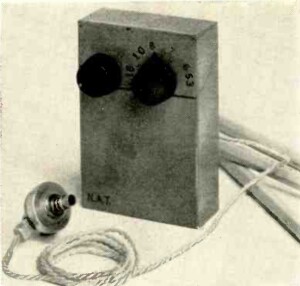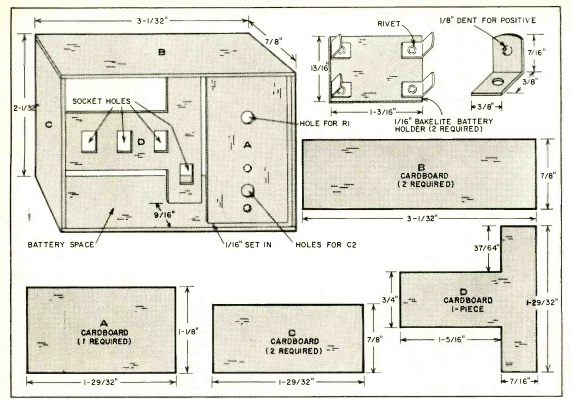 z
z
 Sixty years ago, the May 1961 issue of Radio Electronics showed how to assemble this four-transistor pocket radio. Many items of this era were billed as being “about the size of a pack of cigarettes,” but this one really was. The cabinet was constructed using a cigarette flip top box.
Sixty years ago, the May 1961 issue of Radio Electronics showed how to assemble this four-transistor pocket radio. Many items of this era were billed as being “about the size of a pack of cigarettes,” but this one really was. The cabinet was constructed using a cigarette flip top box.
The magazine gave detailed instructions for constructing it. The first step was to carefully cut off the top where it hinges. Various slots were added, and additional cardboard inserts were placed inside for various compartments. At this point, the cardboard box was painted with two coats of Duco household cement, thinned down to a paintlike consistency with laquer thinner or nail-polish remover. After this was thoroughly dry, you would paint the box with your favorite color enamel and let it try for a few days. The top would be sanded lightly or steel wooled to allow the top to fit back on snugly. The finishing touch was calibrating the dial with the customary markings of 53 through 16 with a “toy printing or rubber-stamp set.” Each number was held with tweezers, coated by a piece of glass with a thin coat of paint, and pressed to the case.
The chassis could be a standard printed circuit board, and the magazine showed the pattern. Or, another option was to build a circuit board using another piece of cardboard treated with the diluted Duco.
After all that work building the handsome cabinet, you wouldn’t want to skimp on the electronics, and this circuit didn’t. It used a Philco AO-1 transistor as the regenerative detector, along with three of the venerable 2N107 transistors as audio amplifier. The receiver was tested by the publisher, and performed quite well. From the test location 20 miles from New York City, the set was able to pull in nine stations with good earphone volume. It noted that it probably could have heard more stations with careful tuning. The loudest station, which was seven miles away, was loud enough to be heard by two persons with the earphone in a small dish on the table between them.
The author reported similar good results at his location. He noted that it was very selective over the entire broadcast band. He reported at night hearing stations 400 miles away, and three stations 1500 miles away. He also reported that on local stations, he could listen with the earphone six feet away.

